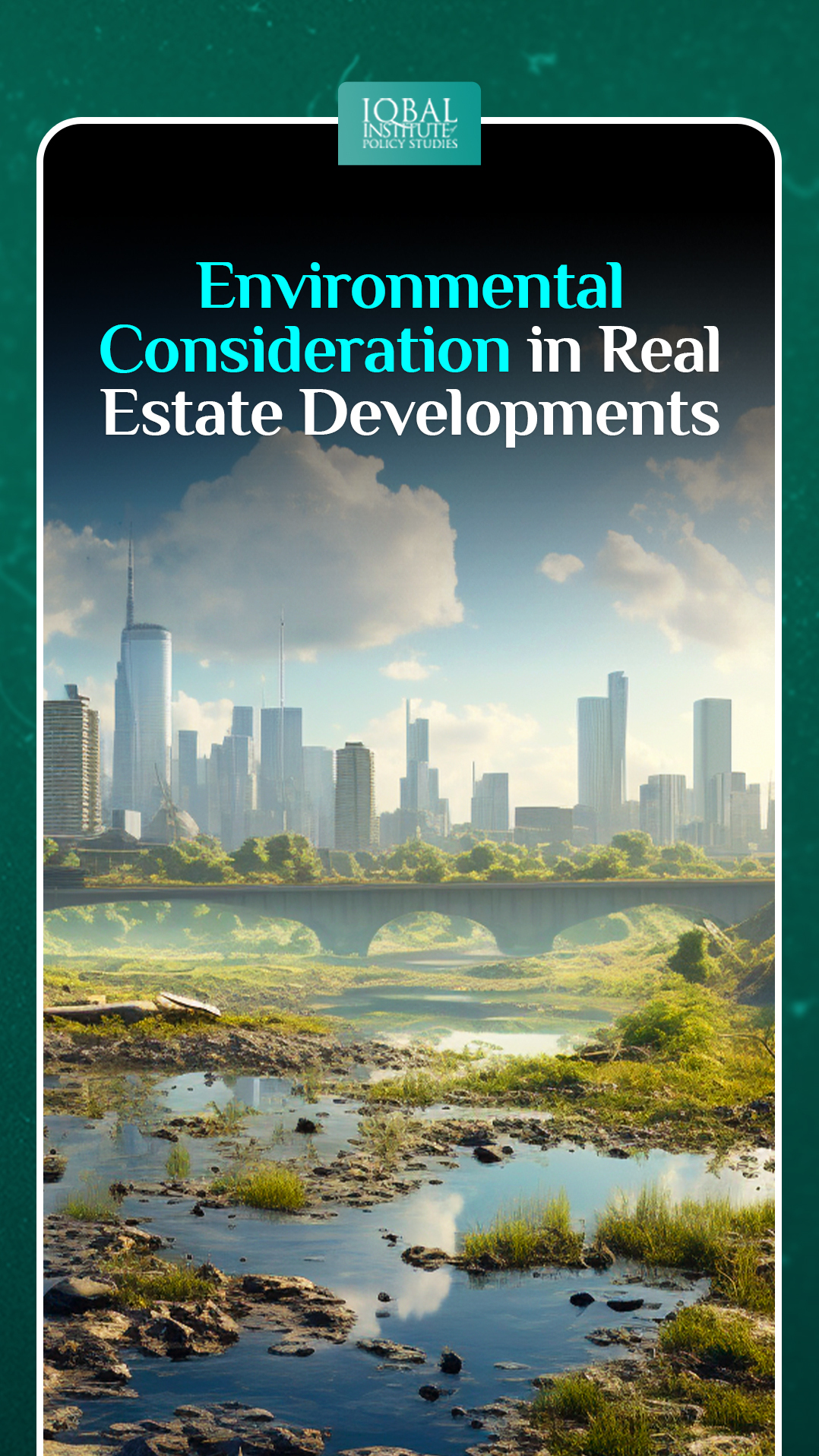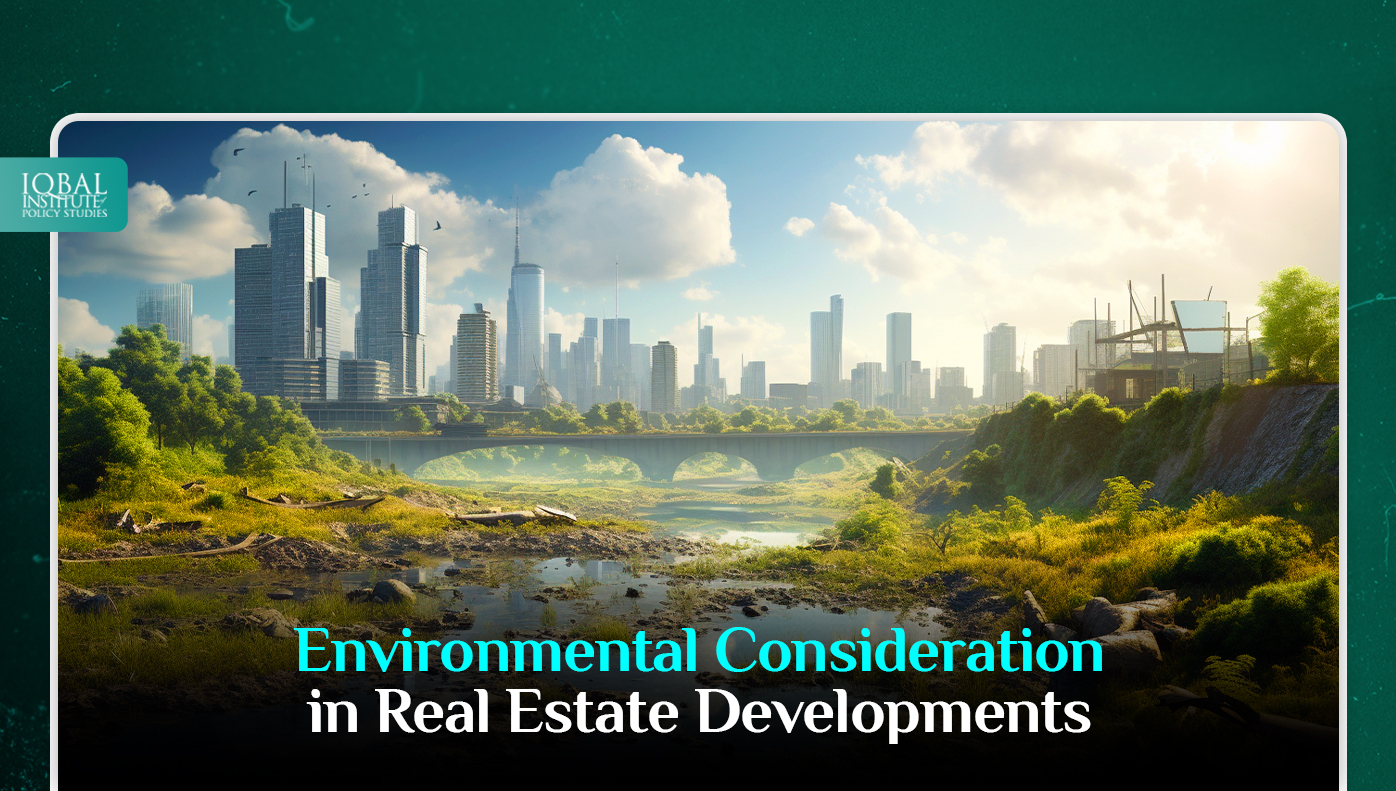In today’s world, the importance of environmental considerations in real estate development cannot be overstated. As urban areas expand and natural resources face increasing pressures, incorporating sustainable practices in land acquisition and development projects is crucial. By prioritizing environmental factors, developers can minimize negative impacts and create a healthier, greener, and more sustainable built environment. This blog explores various environmental considerations in Pakistan’s real estate development and highlights sustainable practices’ benefits.
Major Environmental Considerations
When it comes to real estate development, there are several key environmental considerations that should be taken into account to ensure sustainable and responsible practices. Some of these include Environmental Impact Assessments, sustainable site selection, water and energy, preserving biodiversity, and effective waste management practices. By implementing these practices, developers can ensure that their projects minimize harm to the environment, improve the quality of life for residents, and contribute to a greener and more sustainable future.
Environmental Impact Assessment (EIA)
Environmental Impact Assessment (EIA) is crucial in addressing environmental considerations in real estate development projects. It is a systematic and comprehensive process that evaluates the potential environmental effects of a proposed project, ensuring that developers and stakeholders are aware of the potential impacts and can implement appropriate mitigation measures. An EIA aims to identify and assess a project’s potential adverse environmental effects, both during the construction phase and throughout its operational lifespan. An EIA provides a holistic understanding of the project’s potential impacts on various environmental aspects, such as air quality, water resources, biodiversity, and ecosystems, by conducting baseline studies and impact identification. This assessment allows developers to identify potential risks and challenges and devise effective strategies for minimizing and managing those impacts. Through an EIA, developers can proactively address environmental concerns, ensure compliance with legal requirements, and integrate sustainable practices into the project’s design and operations, ultimately promoting a more environmentally responsible approach to real estate development.
Sustainable Site Selection
Selecting suitable sites for real estate development is pivotal in minimizing environmental impacts. Sustainable site selection considers proximity to public transportation, existing infrastructure, and conservation areas. By choosing well-connected locations and already developed ones, developers can reduce the need for extensive land clearing and promote efficient resource use. Sustainable site selection also enhances the quality of life for residents by providing access to amenities, reducing commute times, and preserving natural surroundings.
Green Building Practices
Green building practices are integral to environmental considerations in real estate development. By adopting sustainable building materials, techniques, and designs, developers can significantly reduce the environmental impact of their projects. One key aspect of green building is the use of sustainable materials. This involves selecting materials with low carbon footprints, such as recycled or reclaimed materials, responsibly sourced wood, and low-emission products. Additionally, incorporating energy-efficient designs, such as optimal insulation, natural lighting, and passive cooling systems, can greatly reduce energy consumption in buildings. Renewable energy technologies, like solar panels and geothermal systems, further enhance real estate projects’ sustainability. Green buildings also prioritize water efficiency by integrating water-saving fixtures, rainwater harvesting systems, and greywater recycling. These practices minimize the strain on water resources and contribute to cost savings for residents and developers alike. Furthermore, green buildings promote improved indoor air quality through proper ventilation, non-toxic materials, and effective air filtration systems, leading to healthier living and working environments. By incorporating green building practices, real estate developers can contribute to a more sustainable future and reap the economic rewards associated with environmentally conscious development.
Water and Energy Conservation
Water and energy conservation are critical considerations in real estate development. Developers can reduce the strain on local water resources by implementing water conservation strategies such as rainwater harvesting, greywater recycling, and efficient irrigation systems. Likewise, integrating energy-saving measures like solar panels, energy-efficient appliances, and smart building management systems can significantly reduce energy consumption and carbon emissions. These practices contribute to environmental sustainability and help residents save on utility bills in the long run.
Biodiversity Conservation
Real estate development projects have the potential to impact local ecosystems and biodiversity. To mitigate these effects, protecting and enhancing biodiversity during the development process is essential. Preserving natural habitats, incorporating green spaces, and promoting native vegetation is crucial to conserving biodiversity. Moreover, developers can implement sustainable landscaping practices that provide ecosystem services, such as pollinator-friendly gardens and green roofs. Real estate projects can contribute to healthier ecosystems and improved urban biodiversity by prioritizing biodiversity conservation.
Waste Management
Proper waste management is a vital aspect of environmentally conscious real estate development. The construction and operation of real estate projects generate significant waste, including construction debris, packaging materials, and ongoing operational waste. To mitigate the environmental impact of waste, developers should prioritize waste reduction strategies, recycling initiatives, and efficient waste disposal methods. Real estate projects can significantly reduce pollution, conserve resources, and improve public health by implementing effective waste management practices. One key strategy for waste reduction is waste segregation at the source. By implementing a system that encourages separating different types of waste, such as recyclables, organic waste, and non-recyclables, developers can ensure that valuable resources are diverted from landfills and sent for recycling or composting. Promoting responsible consumption practices among residents and tenants, such as discouraging single-use plastics and encouraging reusable materials, can further reduce waste generation. Furthermore, the incorporation of efficient waste disposal methods, such as waste-to-energy technologies or anaerobic digestion systems, can help harness the energy potential of organic waste while minimizing landfill space and methane emissions. By adopting these waste management practices, real estate projects can significantly reduce waste and its environmental impact.
Legal and Regulatory Considerations
In Pakistan, environmental laws and regulations govern real estate development activities. Compliance with these legal frameworks is essential to ensure sustainable practices and protect the environment. Understanding relevant environmental laws, including those related to land use, waste management, and pollution control, is crucial for developers. Non-compliance can result in penalties and legal consequences. Government agencies and environmental impact assessment authorities are vital in monitoring and enforcing environmental regulations and promoting responsible development practices.
Conclusion
Environmental considerations in real estate development are essential for creating a sustainable future. By incorporating sustainable practices, developers can minimize environmental impacts, reduce resource consumption, and enhance the quality of life for residents. From conducting Environmental Impact Assessments to implementing green building practices, conserving water and energy, protecting biodiversity, and managing waste effectively, each step contributes to a more sustainable built environment. Developers and stakeholders must prioritize sustainability and environmental responsibility to create vibrant, resilient, and eco-friendly communities that will endure for generations.
This article is written by Radma Nouman. Radmais a research analyst at the Iqbal Institute of Policy Studies (IIPS).



Leave a Reply